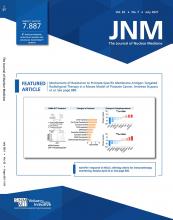See the associated article on page 905.
The Netherlands have a proud history of nuclear medicine shaped by academic centers such as Academic Medical Center (University of Amsterdam) and VU University Medical Center (Vrije Universiteit Amsterdam), the University of Groningen, Erasmus Medical Center in Rotterdam, and others. Eric Krenning, Dik Kwekkeboom, and their colleagues, together with other European scientists, created the field of neuroendocrine tumor theranostics. Quantitative PET imaging was pioneered by Adriaan Lammertsma and coworkers, and the leading oncologist Elisabeth deVries integrated PET imaging into her field. Dutch scientists led international standardization efforts, made critical contributions to preclinical and clinical image instrumentation, and facilitated the successful clinical translation of cardiologic and neurologic applications. Taken together, Dutch basic, translational, and clinical scientists and clinicians represented a strong and internationally winning team that moved the field forward.
The broad and deep impact of Dutch molecular imaging culture underscores that nuclear medicine is much more than hybrid imaging. Nevertheless, following the logic that hybrid imaging is the present and sole future of nuclear medicine, the Dutch societies of nuclear medicine and radiology, respectively, combined their residencies, their specialty boards, and their program review committees in 2015. The combined program has a duration of 5 y, including a 2.5-y common trunk (general radiology) and a 2.5-y differentiation (focus on 1–2 subspecialty fields). The proposed and subsequently implemented combined program was designed in 2013 and a task force “agreed fairly quickly that there was no way to envision radiology and [nuclear medicine] still being 2 distinct and separate medical specialties in the future” (1). A complete integration of radiology and nuclear medicine in The Netherlands was subsequently approved by 68% and 98.5% of membership of the Dutch societies of nuclear medicine and radiology (1).
In a study published in the current issue of The Journal of Nuclear Medicine, Velleman et al. surveyed 114 residents to better understand their motivations for or against joining the nuclear medicine subspecialty (2). Only a few respondents were nuclear medicine trainees. Among the incentives for pursuing a nuclear medicine career as indicated by respondents were quality of supervision, education, innovation, research opportunities, diversity of pathologic conditions, and the increasing role of hybrid imaging. Among disincentives were lack of training integration, imbalance at the expense of nuclear medicine, uncertainty regarding international recognition, and limited employment opportunities. Some survey results are particularly intriguing. Nuclear medicine residents have a greater affinity for research than radiology residents, as 79% of nuclear medicine residents but only 57% of radiology residents were working toward a PhD. The same trend is evident regarding general interest in research (67% vs. 26%).
The most striking outcome of the merger of the 2 disciplines was, however, not part of the survey but is mentioned in the Discussion section: although around 50 residents trained in nuclear medicine in The Netherlands before 2015, this number declined to 14 after the implementation of the new program. Because of this more than 70% decrease within just 5 y, the question is not “if” but “when” nuclear medicine as a strong and innovative discipline will disappear in The Netherlands.
What can we conclude from the survey and the dwindling number of nuclear medicine trainees in The Netherlands? Hybrid imaging (e.g., PET/CT) will continue to grow, and radiologists and nuclear medicine subspecialists will be well-trained to read these scans. Molecular imaging and therapy innovation will slow because those who drive the science will no longer exist in sufficient numbers. At the same time, intellectual (and monetary) investments will decline because only very few dedicated and enthusiastic trainees will embark on careers in preclinical research, translational molecular imaging research, and theranostic research. Creating a generation of great hybrid imaging interpreters is one possible training goal. Fostering a training environment that creates translational researchers to move the field forward is, however, a long-term goal that pays higher dividends.
The ill-fated Dutch experiment coincided with an ever-growing imaging probe, biomarker, and theranostics portfolio and market. This, together with an urgent need to create feasible molecular radiotherapy dosimetry approaches, requires an increasing number of well-trained nuclear medicine specialists. The dissolution of independent nuclear medicine is even more difficult to understand given the pioneering work of Erasmus Medical Center, which cocreated the entire transformative field of theranostics. The blossoming future of theranostics will be handed to radiation oncology, urology, or oncology—whoever is willing to fill the vacuum.
We are convinced that nuclear medicine reaches far beyond hybrid imaging and is fully deserving of its own independent curriculum (3,4). From a position of independence and strength, nuclear medicine should continue to collaborate closely with radiology, radiation oncology, urology, oncology, cardiology, neurology, endocrinology, and all the other clinical partners. The merger of the 2 disciplines appears to be failing in The Netherlands. This may serve as a dire warning for other professional nuclear medicine societies tempted to move in a similar direction. Never change a winning team, but always change a losing one. It seems to be the right time to rethink the concept.
DISCLOSURE
No potential conflict of interest relevant to this article was reported.
Footnotes
Published online Mar. 12, 2021.
- © 2021 by the Society of Nuclear Medicine and Molecular Imaging.
REFERENCES
- Received for publication March 12, 2021.
- Accepted for publication March 12, 2021.







